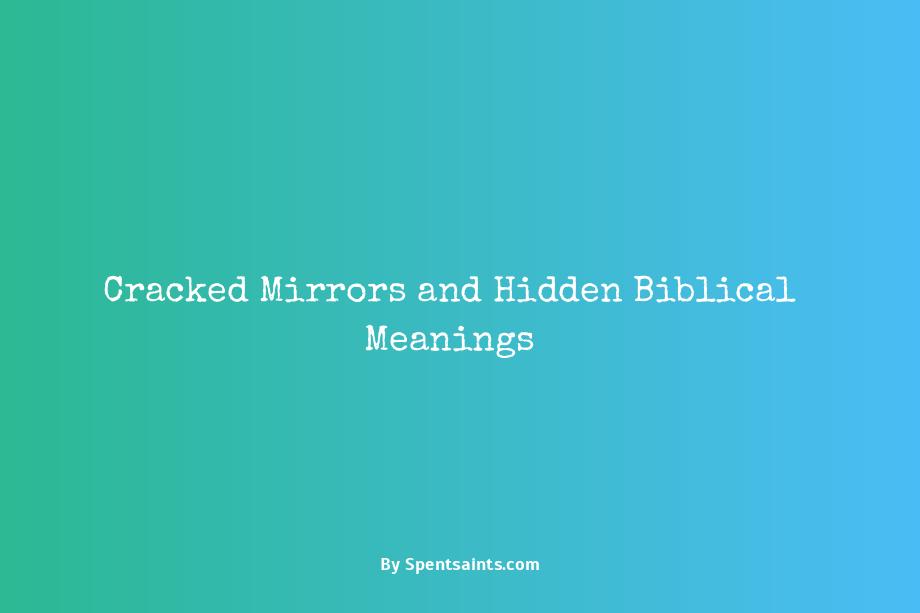Mirrors hold deep symbolic meaning in many cultures and religions, often reflecting inner truths. When a mirror cracks, it can signify shifts within. What does the Bible say about broken mirrors? An exploration of the biblical meaning reveals richer perspectives.
Mirror Symbolism in Religion and Mythology
Across faiths and folklore, mirrors represent wisdom, truth, reflection, vanity, and the soul:
- In Buddhism, bronze mirrors symbolize the calm, reflective mind that sees reality. Breaking disrupts peaceful insight.
- Chinese mythology speaks of mirrors revealing one’s true self without illusion. Fractures indicate inner fragmentation or lost virtue that takes years to restore.
- Ancient Egyptians used polished metal mirrors in rituals to honor Hathor, goddess of beauty and love. Breakage signified a split from one’s spiritual mirror or divine counterpart that impeded sacred sight.
- In Mesoamerican beliefs, mirrors enabled communication with other realms. Shattering disrupted connections between worlds, limiting perception.
- Hinduism links mirrors to consciousness. Fractures distort one’s perception of self/reality. Mended mirrors represented reclaimed understanding.
Clearly, across faiths broken looking-glasses disturb sacred revelations, often reflecting and impacting inner sight. Do biblical mirrors hold similar connotations?
Broken Mirror Imagery in Scripture
References to mirrors in the Bible also connect to truth and wisdom:
- Exodus 38:8 describes the bronze laver basin priests used to purify themselves before entering the Holy of Holies, signifying preparation to receive divine revelation. Breaking such vessels desecrated sacred sight.
- Job 37:18 speaks of God “spreading out the skies, hard as a mirror of cast bronze,” suggesting heavens mirroring divine order in creation. Fractures imply disturbing this cosmic reflection.
- 1 Corinthians 13:12 says “…now we see only a reflection as in a mirror; then we shall see face to face. Now I know in part; then I shall know fully,” contrasting humanity’s limited spiritual perception against God’s perfect understanding and truth. Cracked sight represents distorted glimpses of reality.
- James 1:23-25 compares those who hear God’s Word but fail to act to ones glancing quickly at mirror reflections then forgetting their appearance, indicating shallow perception and spiritual blindness. Breakage exacerbates such conditions.
Such verses relate mirrors to purified revelation, cosmic order, truth perception, and spiritual vision. What deeper impact might their fracture hold?
Interpreting the Symbolic Meaning of Breakage
No Bible verse explicitly explains broken mirrors. But as vessels symbolizing sacred revelation, cracks carry spiritual weight. Possible biblical meanings include:
- Distortion of truth/self-perception: Fractured mirrors in Scripture represent seeing reality darkly, not facing truth. Breakage creates spiritual blindness and self-delusion preventing whole understanding.
- Disconnection from the divine: Since mirrors reflect higher insights, cracks indicating blocked sacred sight/communication with realms beyond physical understanding.
- Desecration of holy items: Scripture prohibits destroying sacred instruments. Breaking ritual mirrors defiled their divine purpose, cutting off access to the truths they revealed.
Of course, without explicit biblical explanation, such symbolic interpretations remain speculative. But parallel themes in other faiths lend perspective into the spiritual distortions shattered mirror imagery conveys.
Finding Deeper Meaning in Cultural Superstitions
Societies widely consider broken mirrors bad omens. Exploring cultural roots and archetypes reveals deeper universal significance.
Common Western Beliefs and Theories
In Western culture, broken looking-glasses carry enduring superstitions of bad luck. Possible roots include:
- Pagan beliefs: Cultures viewing mirrors as magical portals considered fractures destructive to protective wards, exposing one to unseen harms.
- Early Christianity: As sacred icons, breaking mirrors desecrated items of spiritual devotion and channeling of higher truth, cutting this off.
- Greek mythology: Stories tell of Narcissus wasting away after falling for his own reflection. Shards embodied mortal vanity preventing true self-insight.
Historians trace the enduring seven years bad luck omen to numerology:
- In Catholicism, seven represented divine perfection against sin. Breaking a religious artifact merited a full cycle of penance to restore spiritual alignment.
- In multiple faiths, seven connected to body renewal cycles. A broken looking glass threatened this order, promising ill fortunes for equally long.
Therefore, aside from practical concerns, societal mirror taboos likely arose from their sacred symbolism and mystical numerological significance.
A Cross-Cultural Exploration of Meaning
Curious parallels also emerge across cultures:
- Chinese traditions hold broken mirrors bring familial conflicts and relationship issues for years equal to the shards, believed to reflect inner disharmony.
- Irish lore warns looking at one’s reflection in fractured glass foretells illness or death befalling loved ones, hinting at the externalization of inner turmoil.
- In India, breaking temple mirrors reflecting deities carried penalties of social exclusion until ritual purification, emphasizing spiritual re-alignment to regain lost sight.
Clearly, shared cross-cultural motifs link fractured mirrors to distorted self-and-other perceptions, broken relationships, and blocked sacred visions due to spiritual impurity. Such archetypes further bolster universal symbolic significance.
What meaning arises from mirrors cracked through culture, myth, and scripture? One may recognize the self fractured, sacred sight severed, truth obscured. Resulting darkness no trick of light or time. For when soul-windows break, what shatters still reflects some broken part within now laid bare. And perhaps the legendary seven years bad luck owes less to fate than the years it takes facing those jagged pieces to let truth and light return. For as reflections of reality and relationship, what breaks outside but not inside?
So gaze not with dread into those splintered shards but courage to confront the cracks that shaped their shattering. The spiritual vision waits still beneath, awaiting those bold enough to gather up the broken pieces to meet themselves anew and let the inner light shine through.

Dreams, spirit, growth – I explore them all. Laugh, learn, grow with me. Unlock your inner guru.
